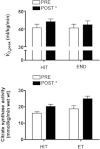Physiological adaptations to low-volume, high-intensity interval training in health and disease
- PMID: 22289907
- PMCID: PMC3381816
- DOI: 10.1113/jphysiol.2011.224725
Physiological adaptations to low-volume, high-intensity interval training in health and disease
Abstract
Exercise training is a clinically proven, cost-effective, primary intervention that delays and in many cases prevents the health burdens associated with many chronic diseases. However, the precise type and dose of exercise needed to accrue health benefits is a contentious issue with no clear consensus recommendations for the prevention of inactivity-related disorders and chronic diseases. A growing body of evidence demonstrates that high-intensity interval training (HIT) can serve as an effective alternate to traditional endurance-based training, inducing similar or even superior physiological adaptations in healthy individuals and diseased populations, at least when compared on a matched-work basis. While less well studied, low-volume HIT can also stimulate physiological remodelling comparable to moderate-intensity continuous training despite a substantially lower time commitment and reduced total exercise volume. Such findings are important given that 'lack of time' remains the most commonly cited barrier to regular exercise participation. Here we review some of the mechanisms responsible for improved skeletal muscle metabolic control and changes in cardiovascular function in response to low-volume HIT. We also consider the limited evidence regarding the potential application of HIT to people with, or at risk for, cardiometabolic disorders including type 2 diabetes. Finally, we provide insight on the utility of low-volume HIT for improving performance in athletes and highlight suggestions for future research.
Figures



Comment in
-
Comment on the paper by Gibala, Little, Macdonald and Hawley entitled physiological adaptations to low-volume, high-intensity interval training in health and disease.J Physiol. 2012 Jul 15;590(14):3389; author reply 3391. doi: 10.1113/jphysiol.2012.232652. J Physiol. 2012. PMID: 22826303 Free PMC article. No abstract available.
References
-
- Bartlett JD, Close GL, MacLaren DP, Gregson W, Drust B, Morton JP. High-intensity interval running is perceived to be more enjoyable than moderate-intensity continuous exercise: implications for exercise adherence. J Sports Sci. 2011;29:547–553. - PubMed
-
- Benton CR, Nickerson JG, Lally J, Han XX, Holloway GP, Glatz JF, Luiken JJ, Graham TE, Heikkila JJ, Bonen A. Modest PGC-1α overexpression in muscle in vivo is sufficient to increase insulin sensitivity and palmitate oxidation in subsarcolemmal, not intermyofibrillar, mitochondria. J Biol Chem. 2008;283:4228–4240. - PubMed
-
- Burgomaster KA, Hughes SC, Heigenhauser GJ, Bradwell SN, Gibala MJ. Six sessions of sprint interval training increases muscle oxidative potential and cycle endurance capacity in humans. J Appl Physiol. 2005;98:1985–1990. - PubMed
-
- Chen Z-P, McConell GK, Michell BJ, Snow RJ, Canny BJ, Kemp BE. AMPK signaling in contracting human skeletal muscle: acetyl-CoA carboxylase and NO synthase phosphorylation. Am J Physiol Endocrinol Metab. 2000;279:E1202–E1206. - PubMed

